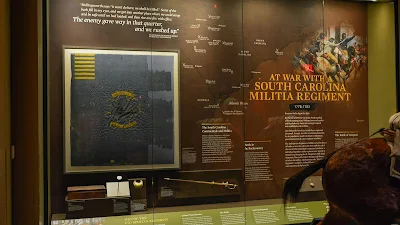Here is some exciting news. Thank you for Bill on the Fire & Drum miniature board for bringing this to my attention. The Museum of the American Revolution has on display a Militia flag from the Spartan SC regiment. There are so few colors still in existence that any new one adds to our knowledge. And this one is amazing! Pictures on this post are all from the Museum of the American Revolution.
Here is the blurb from the museum about it:
"after being hidden away for more than two centuries, this flag is on public display at the Museum for the first time since it flew over the regiment during the Revolutionary War. The newly discovered flag is one of fewer than half a dozen surviving Revolutionary War flags from the South. The regimental flag of the 2nd Spartan Regiment marked its position on the battlefield. The flag shows a “spartan dog” as well as a rattlesnake. The dog symbolizes a bloodthirsty man, from a reference in Shakespeare’s Othello. The snake appears in many Middle and Southern colonial images as an American symbol of defense. Revolutionaries often used the rattlesnake to symbolize American resistance, but questions remain about the meaning of the snake and the dog. Does the snake represent American resistance and unity or the British threat? Does the Spartan dog represent scrappy South Carolinians or bloodthirsty redcoats and loyalists?"
Most interesting! Recently I had considered not giving militia units colors. I will have to reconsider this.
For comparison here is a modern reconstruction of the colors of the 2nd South Carolina Regiment of the Continental line. Some similarities.



















































